Regarding paper sizes, the world isn’t unified under a single standard. Different regions have developed their systems with unique measurements and applications. The three most prominent standards—ISO, US, and UK—vary significantly, reflecting historical practices and modern needs.

Understanding these differences is essential for anyone involved in printing, design, or international business, as it helps ensure that documents are formatted correctly and materials are produced to the correct specifications. This article will explore the critical distinctions between ISO, UK, and US paper sizes, shedding light on how they impact various industries.
Different Paper Sizes Standards
As a professional paper manufacturer, it’s essential to understand the various paper size standards used globally, particularly ISO, UK, and US standards. Each of these standards has a system that is widely adopted in different regions for various applications.
ISO Paper Sizes
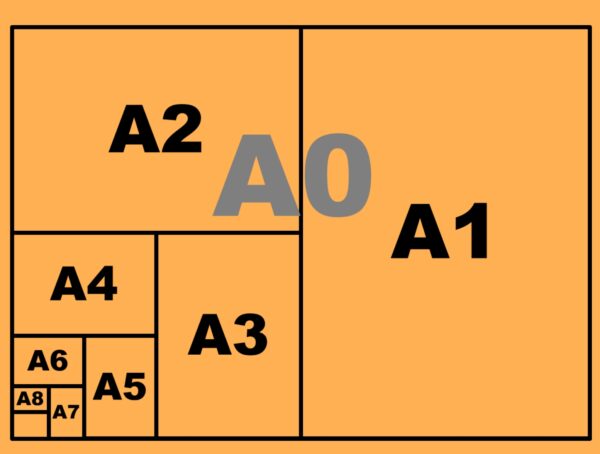
The ISO (International Organization for Standardization) paper size system is the most commonly used standard worldwide, especially in Europe, Asia, and Africa. The most popular series under this system is the A series, which includes sizes like A4, A3, and A5. The A series is based on a simple and logical relationship: each size is half of the previous one when folded parallel to its shorter sides. For example, A4 (210 x 297 mm) is half the size of A3 (297 x 420 mm). This system allows for efficient scaling and consistent aspect ratios across different sizes.
US Paper Sizes
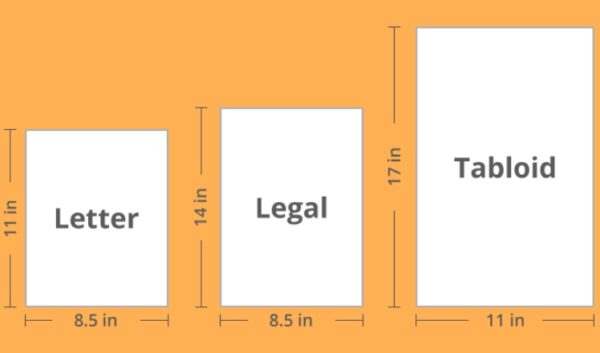
In contrast, the US uses an entirely different system, where the most common size is a Letter (8.5 x 11 inches or 216 x 279 mm). Other popular sizes include Legal (8.5 x 14 inches) and Ledger/Tabloid (11 x 17 inches). Unlike the ISO system, US paper sizes don’t have a straightforward scaling method, leading to differences in aspect ratios and formatting compared to ISO sizes.
UK Paper Sizes

While ISO sizes like A4 are commonly used in the UK, there are also British Imperial sizes, which are less prevalent today. These sizes include Foolscap, Quarto, and Imperial, remnants of an older system. For example, Foolscap measures approximately 203 x 330 mm, slightly longer than A4. However, the A series has replaced these traditional sizes in most everyday applications.
Understanding these different paper size standards is crucial for stationery manufacturers, mainly when producing paper for international markets. Each system has its own unique characteristics and usage patterns, and being able to navigate between them ensures that we can meet the diverse needs of our global customers.
Paper Sizes: ABC Series Sizes
The ABC series is part of the ISO 216 standard, a widely recognized international standard that defines paper sizes used globally. This standard includes three series: A, B, and C, each serving a distinct purpose.
The A series is the most widely used and familiar. It’s based on a rectangle with an aspect ratio of 1√2 (approximately 1:1.414). The A series starts with A0, which has an area of 1 square meter, and each subsequent size is half the area of the previous one.
The B series provides sizes between those of the A series. The B series is also based on the same aspect ratio of 1√2, but the sizes are more significant than the A series by a factor of √2.
The C series is mainly used for envelopes and is sized to fit A series paper. For example, a C4 envelope can hold an A4 sheet unfolded, while a C5 envelope can hold an A4 sheet folded in half.
A Series Paper Sizes
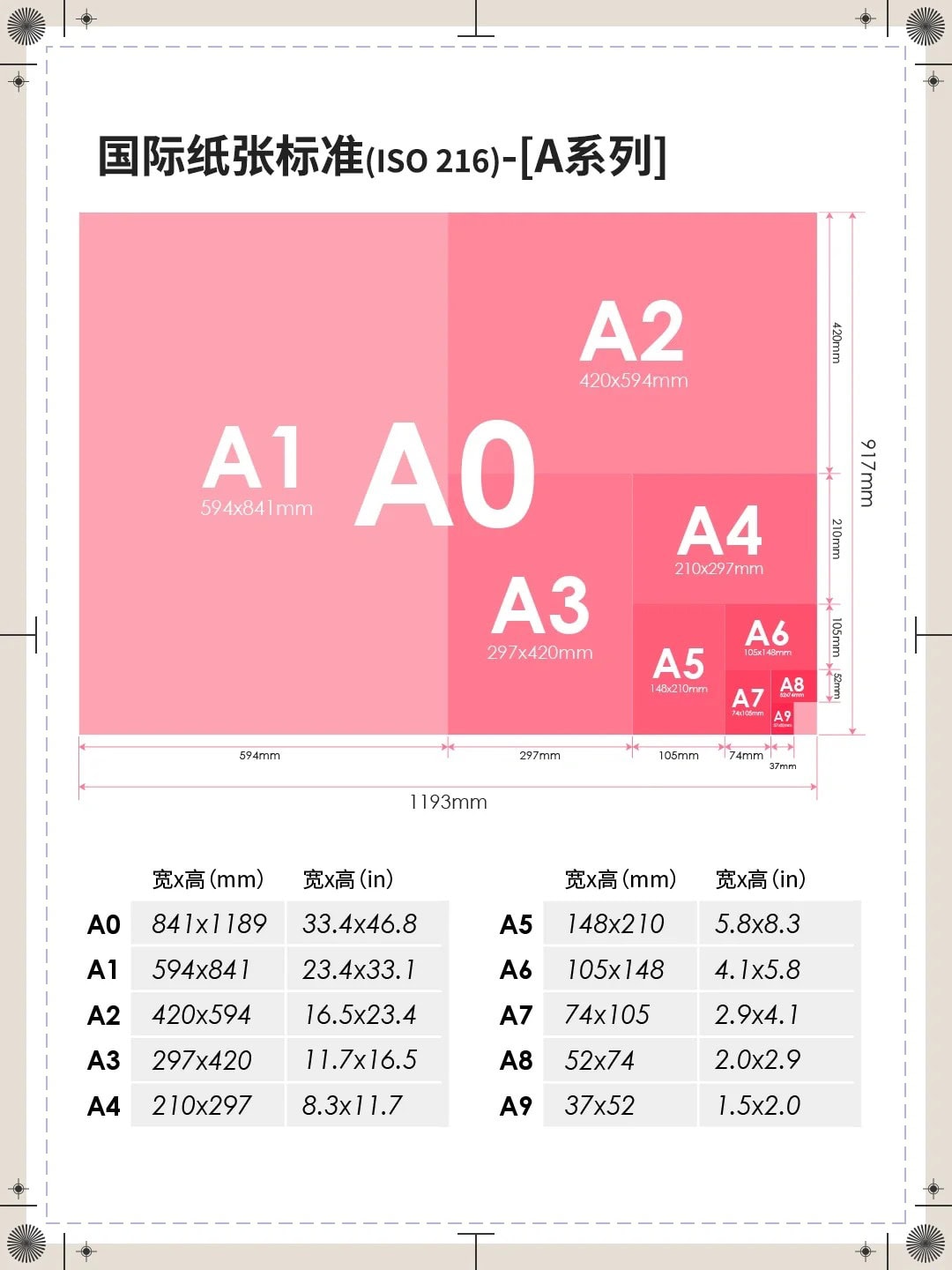
B Series Paper Sizes

C Series Paper Sizes
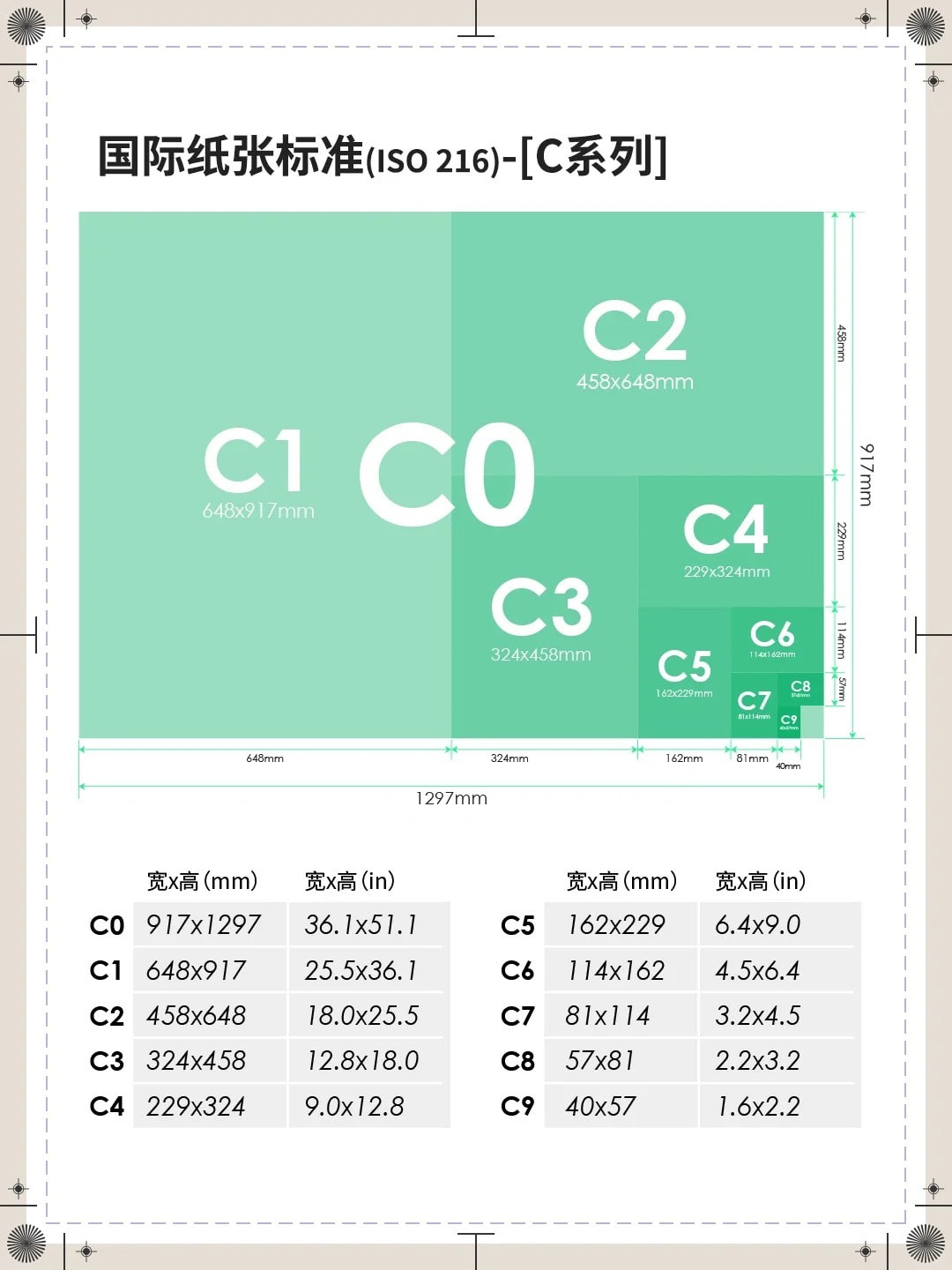
- A Series: Primarily used for standard documents, books, and posters.
- B Series: Often used for more giant posters, art, and industrial applications.
- C Series: Specifically designed for envelopes and related packaging.
Each series is designed to complement the others, providing a comprehensive system for paper sizes that can be used across various applications, ensuring consistency and efficiency in production and usage.
Common Paper Sizes
Choosing a paper size is crucial in your work’s final presentation and usability when it comes to printing, writing, or creating documents. Whether preparing reports, crafting invitations, or designing marketing materials, understanding the most common paper sizes can help you.
Commonly used in printers

- A4: 210 x 297 mm (8.27 x 11.69 inches)
- Letter: 216 x 279 mm (8.5 x 11 inches)
- Legal: 216 x 356 mm (8.5 x 14 inches)
- A3: 297 x 420 mm (11.69 x 16.54 inches)
- A5: 148 x 210 mm (5.83 x 8.27 inches)
These copy paper sizes are the most frequently used in everyday printing tasks. Depending on the region, A4 and Letter are the standard sizes for most documents, such as letters, reports, and academic papers. Legal size offers extra length, making it ideal for legal documents and forms. A3 is commonly used for larger prints, such as posters and diagrams, while A5 is perfect for smaller items like booklets and flyers.
Commonly used in envelopes

- DL: 110 x 220 mm (4.33 x 8.66 inches)
- C4: 229 x 324 mm (9.02 x 12.76 inches)
- C5: 162 x 229 mm (6.38 x 9.02 inches)
- C6: 114 x 162 mm (4.49 x 6.38 inches)
- A2: 111 x 146 mm (4.37 x 5.75 inches)
These sizes accommodate various paper formats, ensuring that documents, cards, and invitations fit snugly and securely within the envelope. The DL size is trendy for business correspondence, while C4 and C5 are commonly used for official documents and letters. C6 and A2 envelopes are perfect for personal notes and greeting cards, offering a range of options to suit different types of mail.
Please click Standard Envelope Sizes and Styles: Your Complete Guide to learn more.
Commonly used in newspapers

- Broadsheet: 600 x 750 mm (23.5 x 29.5 inches)
- Tabloid: 280 x 430 mm (11 x 17 inches)
- Berliner: 315 x 470 mm (12.4 x 18.5 inches)
These newspaper formats cater to different types of content and readership. The broadsheet is typically associated with traditional, high-quality journalism, offering ample space for detailed articles and large images. The more compact tabloid is easier to handle and read on the go, making it ideal for a faster-paced readership. The Berliner format strikes a balance between the two, offering a more manageable size without sacrificing the ability to present in-depth content. Each size plays a specific role in how news is consumed and presented.
Commonly used in notebooks

- A4: 210 x 297 mm (8.27 x 11.69 inches)
- A5: 148 x 210 mm (5.83 x 8.27 inches)
- B5: 176 x 250 mm (6.93 x 9.84 inches)
- A6: 105 x 148 mm (4.13 x 5.83 inches)
These paper sizes cater to different notebook purposes and user preferences. A4 is widely used for detailed note-taking, making it a staple in educational and professional settings. A5 and B5 sizes balance space and portability, making them ideal for personal and academic use. A6 is perfect for those who need a compact, easy-to-carry notebook for on-the-go jotting. Each size provides a specific advantage depending on the intended use, whether for detailed work, casual note-taking, or portable convenience.
Please click Paper Notebook Sizes Explained: The Ultimate Guide to learn more.
FAQ
What is the difference between A and B series paper sizes?
The A series is more commonly used for everyday documents like letters and reports, with A4 being the most popular. The B series provides larger sizes than the A series for each corresponding number, often used for posters, book printing, and industrial purposes.
If you want to know more about A4 paper, click here A4 Paper Size: The Global Standard Explained.
What is the largest paper size available in the ISO standard?
The largest paper size in the ISO standard is A0, which measures 841 x 1189 mm (33.1 x 46.8 inches). It’s often used for large-scale architectural drawings and posters.
How do I choose the right paper size for my project?
The choice depends on your project’s requirements. For standard documents, A4 or Letter size is usually sufficient. You might choose A3, B5, or larger sizes for posters, presentations, or booklets. Consider the purpose, content, and audience when selecting a paper size.
What is the significance of the aspect ratio in ISO paper sizes?
The ISO paper sizes are based on an aspect ratio of 1:2, meaning each size can be scaled up or down by simply folding or cutting in half. This ratio ensures that the proportions remain consistent across different sizes, making it easy to scale documents without altering their layout.
Why is tabloid size popular for newspapers and not for other documents?
The tabloid size is popular for newspapers because it’s more compact and easier to handle than larger formats like broadsheets. This size allows for convenient reading while providing enough space for headlines and images. Standard sizes like A4 or Letter are more commonly used for other documents due to their suitability for printing and binding.











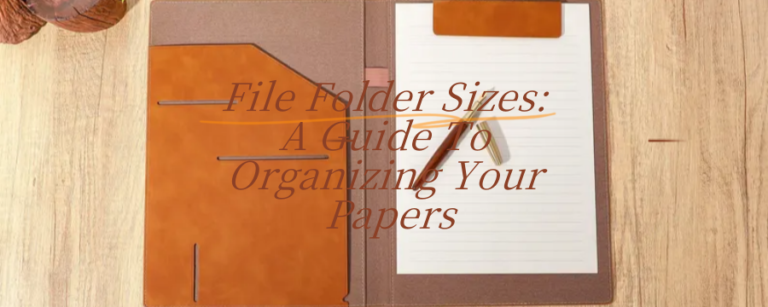

One Response
Understanding these is crucial as we source notebooks from various regions.
I’d like to know if you have any data on which paper sizes are most popular in the notebook market globally. This would help us make purchasing decisions.